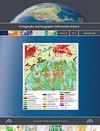使用方向的地形表示
IF 2.4
3区 地球科学
Q1 GEOGRAPHY
Cartography and Geographic Information Science
Pub Date : 2022-03-03
DOI:10.1080/15230406.2022.2035256
引用次数: 1
摘要
摘要使用方向而非高程的地形数据模型可以更有效地进行分析,并将其数据存储在多波段光栅中。这种数据模型很容易采用计算机图形学行业的表示技术。地形表面的常见数据模型——光栅数字高程模型(DEM)——由于强调高度而受到限制。衍生产品,如浮雕着色,需要额外的处理来确定方向,尽管它们的使用频率比那些依赖高程的产品更高(例如高光度着色)。我们展示了基于表面方向对地形进行编码和分析的一些好处,这种方法使用存储为多带光栅的法向量,这是计算机图形行业的数据存储约定。数据模型的变化和曲面定义特征的概念化使浮雕着色方法比传统工具运行得更快。处理效率对于更高级的着色模型尤其有用,该模型可以使用数百个浮雕着色计算。此外,以方位为重点的地形方法允许制图技术与常见的计算机图形学方法并行。该项目探索了一种这样的方法,法线贴图,通过扰动曲面法线向量,将纹理添加到传统的浮雕着色中。本文章由计算机程序翻译,如有差异,请以英文原文为准。
Terrain representation using orientation
ABSTRACT A terrain data model using orientation rather than elevation permits more efficient analysis and stores its data in a multi-band raster. Representation techniques from the computer graphics industry are readily adopted with this data model. A common data model for terrain surfaces–the raster digital elevation model (DEM)–carries with it limitations by emphasizing height. Derived products such as relief shading require additional processing to determine orientation, even though they are used more frequently than those relying on elevation (e.g. hypsometric tinting). We show some of the benefits of encoding and analyzing terrain based on surface orientation, an approach that uses normal vectors stored as multi-band raster, the data storage convention in the computer graphics industry. A change in the data model and the conceptualization of the surface’s defining characteristics allows relief shading methods to run faster than conventional tools. Processing efficiencies are especially useful for more advanced shading models that may employ hundreds of relief shading calculations. In addition, an orientation-focused approach to terrain permits cartographic techniques to parallel common computer graphics methods. This project explores one such method, normal-mapping, an effect that adds texture to conventional relief shading by perturbing surface normal vectors.
求助全文
通过发布文献求助,成功后即可免费获取论文全文。
去求助
来源期刊
CiteScore
5.20
自引率
20.00%
发文量
23
期刊介绍:
Cartography and Geographic Information Science (CaGIS) is the official publication of the Cartography and Geographic Information Society (CaGIS), a member organization of the American Congress on Surveying and Mapping (ACSM). The Cartography and Geographic Information Society supports research, education, and practices that improve the understanding, creation, analysis, and use of maps and geographic information. The society serves as a forum for the exchange of original concepts, techniques, approaches, and experiences by those who design, implement, and use geospatial technologies through the publication of authoritative articles and international papers.

 求助内容:
求助内容: 应助结果提醒方式:
应助结果提醒方式:


